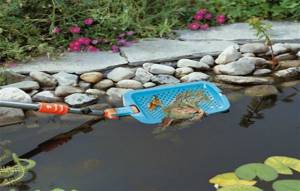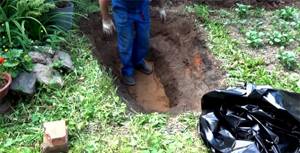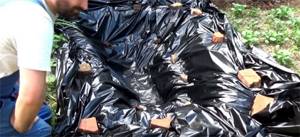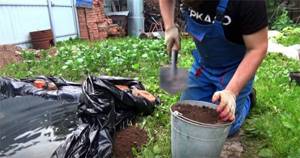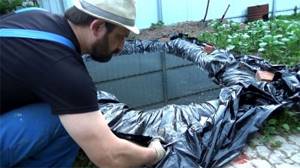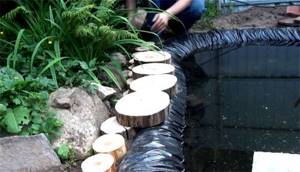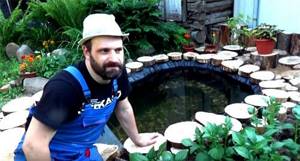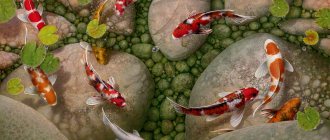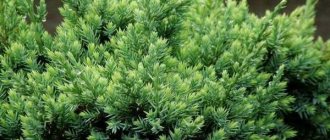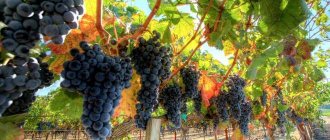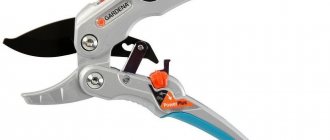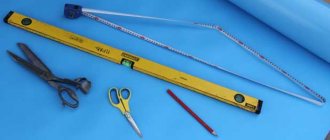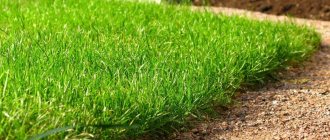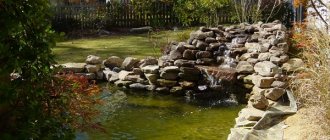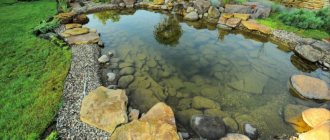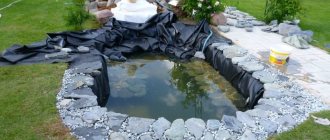When designing an artificial reservoir on your own site, many questions arise that need to be resolved correctly. One of them is waterproofing. You can, of course, try to do without it or use a mechanical option for finishing the bottom, but in this case either the work will be even more labor-intensive, or it will not be possible to achieve constant cleanliness of the pond. That is why many designers and professional builders use the optimal technology - covering the bottom with a special film. What it happens and what the difference is, you will learn from this article.
Leading manufacturers
Today, many manufacturers are engaged in the production of film for ponds.
But not everyone offers materials of decent quality. Elite coatings are produced by companies from Italy, Germany and the USA, while more budget-friendly ones are produced by Polish and Russian brands. We invite you to familiarize yourself with leading manufacturers in different price categories.
| A country | Manufacturer | Film type | Price in rub. for 1 m² on Yandex.Market as of June 2019 |
| PVC | |||
| Italy | Agrilac | Thickness 0.5mm | 250 |
| Germany | Heissner | Thickness 1.0mm | 514 |
| AlfaFol Oase | Thickness 0.5mm | 239 | |
| Butyl rubber | |||
| USA | EPDM PondLiner | Thickness 1.2 mm | 560 |
| RP | Ergis | Thickness 1.0mm | 413 |
| Germany | OASE | Thickness 0.5mm | 239 |
| Polyethylene | |||
| Russia | Anikom | 500 µm | 158 |
Which brand of pond film is best to choose?
When choosing a manufacturer, you should give preference to trusted companies that have been on the market for a long time, have many positive reviews and have an adequate pricing policy. The companies whose products are considered in this rating can be classified as just such companies. Some enterprises are represented here with two products at once.
The five leading companies in the market of manufacturers of waterproofing films for the construction of artificial reservoirs are the following companies:
- Polinet is a company that produces high-quality film for household and construction needs. It is characterized by high strength, resistance to UV rays and low temperatures, and a good degree of elongation. On average, its service life is 20 years, which is easily explained by the wear resistance of the products. The manufacturer's waterproofing membranes are sold in convenient rolls and can be cut depending on the required quantity.
- Anikom - the company produces geomembrane types HDPE (HDPE) and LDPE (LDPE) to create good insulation in artificial ponds. It is widely used in reservoirs intended for both fish farming and swimming. The company's products have excellent tear resistance, retain their appearance well over time and are easy to install.
- Firestone Building Products is a manufacturer of waterproofing materials, including those for artificial ponds of small, medium and large sizes. Its membranes are noted on the market as elastic, durable, easy to install, environmentally friendly and aesthetically pleasing. Here we are talking about butyl rubber products, which last an average of 15 years, and are guaranteed for up to 10 years. In this rating, the company is represented by EPDM films Pond Liner Carlisle and Pondgard.
- Oase is a German supplier of premium equipment for fountains, pools and ponds. Its films come in different thicknesses and a large selection of sizes. The manufacturer guarantees the possibility of reusing materials and safe disposal of no longer needed products. The company's canvases are recognized as waterproof and wear-resistant, withstand low and high temperatures, and retain their aesthetic appearance for a long time. The brand's waterproofing materials Steinfolie granit-grau and AlfaFol are included in the rating.
- Ergis - the company offers to buy butyl rubber film and other types of it for the pond. Their key differences are high strength, resistance to mechanical damage, chemical reagents and impurities in water, resistance to heavy loads and temperature changes. The company's products withstand exposure to both heat and sun. The elasticity of the brand’s materials allows you to create ponds of various, even the most complex shapes. They do not contain dangerous toxins that could kill fish in the pond. Due to their environmental friendliness, Ergis products are also safe for people and the environment.
Each of the companies in the list above promises a long service life of their products (from 10 years) and always provides a guarantee of at least 2-3 years.
The best polyurethane foams
The role of film in pond construction
Pond film as a building element in the design of an artificial reservoir appeared relatively recently due to a large technological breakthrough in recent years. Before this, site owners gave preference to outdated technologies, which impose limitations on both service life and immediate appearance:
- burying unnecessary containers in the ground that have already been used (baths, basins, etc.);
- processing the pit with clay or cement mortar, followed by lining with decorative material.
It should be noted that the first method has a very modern branch - installing a ready-made molded PVC pool into the pit. But if, again, we talk about cost, then this option remains far behind. In the second case, an increased requirement for the quality of the work performed is added, since otherwise the structure may not pass the cold test in winter and fail in the first year of use. This is why the use of film has come to the forefront and become so popular.
As another advantage when using a polymer coating for the bottom of a reservoir, it should be noted that it is possible to create the most varied and non-standard shapes of reservoirs, conveying through the external design a closeness to the natural, which is reflected in the now popular environmental friendliness and durability. That is why many modern landscape designers choose film as a material when making a pit for a decorative pond.
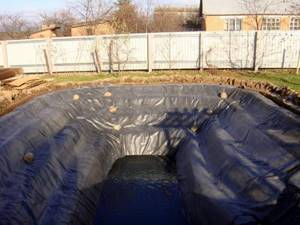
So, summarizing all of the above, we can come to the conclusion that the described material, when creating a reservoir of the required configuration, acts as a reinforcing element in the composition of the container. This means that the film prevents water from flowing beyond the established boundaries or from seeping into the ground. In this case, of course, it is necessary to note the following positive features:
- the form specified initially will be maintained throughout the entire period of operation, and this does not depend on its configuration;
- due to environmental cleanliness, there is no threat to representatives of the fauna of the reservoir, all inhabitants will feel in their natural habitat;
- Due to its high resistance to mechanical damage and high degree of elasticity, the film is not subject to deformation for several decades, and therefore can be reused, for example, if there is a desire to build another reservoir.
As a piece of advice, it can be noted that if doubts of any kind arise when choosing a material, since it is indeed still unusual, then you should pay attention directly to supplies from manufacturers whose sites are equipped with stores with a detailed description of the goods they are producing more than a dozen years.
Large markets differ in this regard in that they have a huge assortment, but often it is not so well sorted and only an expert can understand this variety. For example, stores with a French franchise have a very high demand for film, since their scrupulous approach to improving materials for suburban areas is well known.
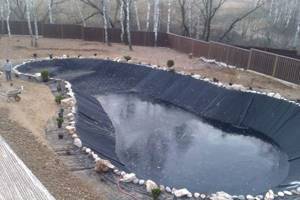
The best plastic films for ponds
This material is advantageous in that it has a high stretch coefficient - up to 300%, which allows you to create reservoirs of very decent size and considerable depth. On average, it can withstand a pressure of 2 kPa, its thickness ranges from approximately 0.5 to 1.2 mm, and its length varies between 25-50 m. It accounts for the largest selection on the market; in the same category, the 3 best polyethylene films for construction of artificial ponds.
Polinet 200 microns technical specifications
This is a technical polyethylene film intended for vapor barrier, but it is also successfully used to create artificial ponds in the garden as one of the layers. It is sold in a roll 100 m long, which allows you to make a fairly large pond, but its width in this case is limited to 3 m. The material is quite dense, does not tear and can withstand exposure to large amounts of water. The product reliably holds it in the pit due to its high strength and does not pose a danger to fish and plants due to its environmental friendliness.
Polinet 200 micron film perfectly retains its elasticity and original appearance for many years, in particular, due to its thickness of 200 microns, and therefore can be reused. Its use reduces the likelihood of water rotting and blooming, and prevents the appearance of an unpleasant odor. It also creates an effective barrier to harmful microorganisms and makes pond maintenance much easier.
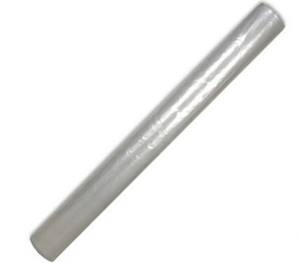
Advantages
- Almost invisible at the bottom;
- Wide range of applications;
- Good density;
- Excellent resistance to mechanical stress;
- Not very slippery.
Flaws
Not detected.
Anikom black 1000 microns, 8x10 m
Anikom film is made on the basis of premium polyethylene with the addition of components that increase its service life. It does not contain dangerous components that harm the environment, fish and plants in the reservoir. It withstands both cold and UV rays and can be used at temperatures from -60 to +60°C. The material is super elastic, has a good margin of strength and is resistant to mechanical damage, and has excellent wear resistance. Thanks to this, the product retains its aesthetic appearance for a long time.

Advantages
- Shelf life – about 70 years;
- Suitable for both hydro- and vapor barrier;
- Good density – 1000 g/m2;
- Creates a reliable insulating layer;
- Considerable dimensions - 10x9 m;
- Excellent thickness – 1000 microns.
Flaws
Weighs 70 kg.
Benefits of using film in pond design
We can talk a lot about the advantages of the film, since it remains invisible after finishing and installation of decorative elements, and retains its elasticity even under the pressure of water and sand. A separate point is the ability of this material to adapt to the intended design, without dictating it in any way. Of course, these are not all the advantages; they can be listed in much greater numbers:
- in an artificial reservoir, where a film is used to strengthen the bottom, avalanche growth of microorganisms and, as a consequence, stagnation of water with its subsequent decay are completely eliminated;
- due to the physical parameters of the material, there are no problems with the contour of a lake or pond slipping, the shape is maintained for a very long time;
- the film itself is non-toxic and therefore very friendly to the fauna of the reservoir, including its inhabitants;
- microorganisms and harmful insects will not be able to penetrate into the reservoir from the soil;
- such a pond is generally unpretentious in operation and requires a minimum of effort both in terms of maintenance, including reconstruction if necessary in a short time, and in terms of caring for plants;
- the correct selection of print or color palette of the film completely changes the appearance of the site, even beyond recognition, making it completely different thanks to the unusual body of water;
- installation of the material can be done on any surface, both ground and frame.
So, as can be seen from the description presented above, the most ordinary film canvas can easily help turn even an ordinary area into a recreational recreation area. You don’t need much to do this, as the experience of many of our compatriots shows, it’s enough to think through the project, putting a good idea into it, calculate and buy the required amount of materials, and then spend about a week of time on completely transforming your favorite area.
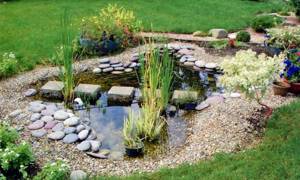
Manufacturers of materials and price review
The most common manufacturers of pond film:
- The Italian company Agrilac produces PVC roll material with waterproofing properties. These products are among the highest quality and most widely available. The cost varies from 150 rubles per square meter.
- Polish organization IZOFOL, producing waterproofing materials. An important aspect in the production of such film is its quality, which is why it is considered one of the most popular. Price from 250 rubles per square meter.
- The most common among German companies producing waterproofing sheets for ponds is WTB ELBEsecur. Customers are offered a limited choice of PVC material, but this does not affect the production of a very durable product. German film is reliable even under heavy loads. The cost of such material starts from 250 rubles per square meter.
- One of the largest European groups of companies engaged in the production of various components for the garden and vegetable garden is Gardena. The administrative complex is located in Germany. The cost for the material is 170-210 rubles per square meter. They produce very high quality products.
- Another German manufacturer is Heissner. They are engaged in the production of chemical materials and also produce PVC products. It is recommended to choose products from these manufacturers only if there are no other options.
- Models of the elite group use various stones of natural origin in decoration. Regardless of the manufacturer, the cost of the material starts from 750 rubles. per square meter.
Advantages of film for artificial reservoirs
Pond care is not a simple technical process. A good insulating coating can save you a lot of hassle. What kind of quality coating is it for swimming pools, ponds, reservoirs and artificial lakes?
Modern manufacturers of insulation materials have invented a reliable waterproofing material that has a lot of advantages:
- An environmentally friendly product, which means that it will not harm the environment or people;
- Reasonable price;
- Large selection of colors and patterns;
- Significant resistance to mechanical and chemical damage;
- High quality material can last up to 50 years;
- Easy and convenient to use when decorating an artificial pond.
Agree that these listed advantages are enough to pay attention to such a material as film insulator. Among owners of suburban areas and landscape designers, pond film has become widely known
This material is not at all difficult to work with.
Naturalness comes first
Any body of water begins with a pit. Then a purchased polymer solid bowl is installed or a concrete one is poured. The polymer bowl has its pros and cons. Among the disadvantages, we will primarily mention the tendency to damage and the stamped shape. Therefore, if you have the physical and material opportunity, give preference to a concrete pond. This is a more durable material, and a concrete bowl provides more opportunities for further decorative transformation of the reservoir.
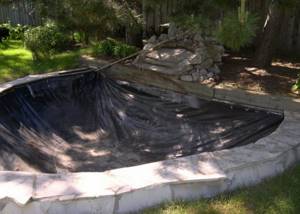
Film covering with concrete filling of the pond
To prevent concrete from crumbling due to exposure to moisture over time, it is lined with tiles, glass mosaics or even marble. But, if we are talking about an artificial pond, then it will only lose from this. Ponds in the garden are erected with the goal of getting closer to nature, and not to emphasize the man-made nature of the design.
Therefore, the relatively new method of film waterproofing helps to cope with this problem. The coating will be smooth, but at the same time will not emphasize the unnaturalness of the reservoir.
Film coating can be divided into three types:
Ultra-thin coating is a film up to 1 mm;
- Ultra-durable coating is a film of 1.5 mm and above;
- Having air bags - a durable coating with air cushions that prevent injuries when falling.
These films are commercially available in both black and all sorts of bright colors. Just look at the names: Blue Lagoon, Golden Sand, White Pearl.
EPDM butyl rubber film
The main advantage lies in the material from which it is made. It is considered a new generation material, having a set of such properties:
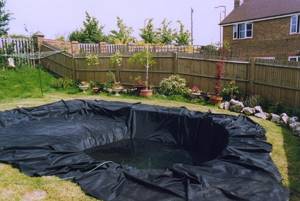
Most often, butyl rubber film is used for arranging a pond.
- High strength in cases of ruptures and punctures;
- Easy installation;
- Resistance to a wide variety of environmental influences;
- Ease of repair of individual areas;
- Safety for all living organisms;
- Can be applied to any surface
- The membrane width can even reach 60 meters;
- Can give the most varied shape to a pond with the ability to change it at any time;
- A wide range of component materials makes it possible to make pump supply areas, corners, and so on more dense;
- Last for a very long time, up to 50 years. Accordingly, we can talk about savings, despite its higher cost.
No significant deficiencies have been identified to date.
Return to content
Which pond film is best to buy?
For those who want to emphasize the beauty of the garden and nature in general, it is best to pay attention to an olive or black membrane that mirrors the sky, sun, and plants in the garden. For the construction of a pond for swimming purposes, blue and turquoise shades will become more relevant, giving a high-quality view of the bottom
The most versatile coating is polyethylene film, which can become either a finishing layer or just part of the overall “pie”, but most often it is additionally decorated with pebbles and stones. The remaining options are used mainly as a finishing touch and do not require mandatory processing with other materials. This task is best accomplished with a gravel option that imitates stone.
Also, when choosing a waterproofing membrane, you should pay attention to its thickness; in the case of constructing small and not very deep streams, 0.5-1 mm will be enough. For the arrangement of large ponds, for example, for the purpose of swimming or breeding fish, the most optimal figure is considered to be 1-1.5 mm
But in any situation, when using film for a pond with drinking water, the manufacturer must provide an appropriate certificate. Such options are quite suitable for creating swimming pools, landscape and swimming ponds.
The choice of any specific waterproofing depends on many factors:
- For use as one of the layers in a waterproofing project, you can take the Polinet 200 micron TU version.
- The black Anikom membrane will help you create a small pond in the garden for purely decorative purposes.
- If you need to cover the bottom of a concrete pit, Firestone Pondgard is your best choice.
- The EPDM Pond Liner Carlisle butyl rubber membrane is quite suitable for creating swimming pools.
- For the purpose of constructing a fish pond, AlfaFol Oase will be relevant.
- To organize, for example, beautiful streams in your country house, it would not be a mistake to buy a PVC model from Ergis.
- Those who want to build a bright decorative pond in the garden are advised to take a closer look at Oase Steinfolie granit-grau products.
Having figured out which pond film is best to buy in your specific situation, you should definitely once again familiarize yourself with its characteristics, advantages and disadvantages.
Characteristics of butyl rubber film
Butyl rubber film for waterproofing a pond is a more expensive material, but its price is completely justified. In terms of strength characteristics, such a fabric is several times higher than that of PVC film. In addition, it is very convenient to work with - it is easy to cut and glue.
Butyl rubber film is also made with a two-layer fabric with reinforcement, which virtually eliminates the possibility of breakthrough and leakage during operation. At its core, this is the same rubber, the basis of which is ethylene diene propylene terpolymer.
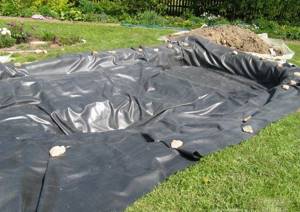
Film parameters
The parameters of this type of material may vary among different manufacturers. Standard options correspond to the following figures:
- width - 1.7-2.1-3.3-4.8-6.1-7.6-9.1-12.2-15.2 meters;
- thickness - 1.02; 1.14 mm;
- length - 15-30-45-61 meters.
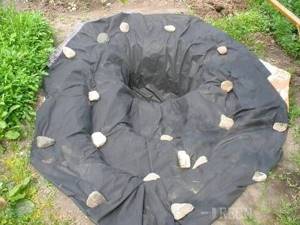
Specifications
The most important distinctive characteristics that determine the advantages of this material and its advantages over PVC film are:
- stretching - 300-450%;
- operating temperatures - from -50C to 120C, short-term heating up to 250C;
- possible contact with drinking water according to ANSI/NSF-61 standard;
- integrity and stability of the blade size during elongation - 100%;
- ozone resistance and ultraviolet exposure - does not deteriorate according to DIN 7864 and ASTM G 53-84 standards.
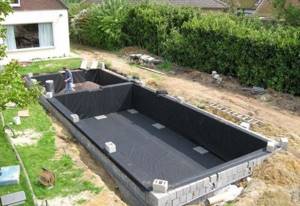
Advantages of rubber film
The advantages of this material are as follows:
- maximum strength, which ensures stable preservation of the integrity of the canvas under any mechanical influence - impacts, pressure loads, stretching, punctures;
- the ability to carry out installation work at any time of the year in any weather;
- excellent for arranging large ponds;
- convenient and easy to use;
- it is based on environmentally friendly components, which makes it possible to use it even for the design of swimming pools, reservoirs for breeding fish and plants;
- a wide range of operating temperatures, therefore suitable for organizing an artificial lake in any climate zone;
- excellent for decorating a pond even on rocky soil, as it is absolutely resistant to tearing;
- possibility of combination with any materials - concrete, soil, wood, stone, metal;
- ideal for recreating the lines of a reservoir as clearly as possible according to the design project - the bottom topography and the slopes of any angle do not matter and do not create difficulties when laying the canvas;
- the specific composition of the material completely eliminates rotting or destruction even after prolonged contact with water;
- wide decorative possibilities, including imitation of finishing with various materials.
Important! The service life of butyl rubber film under any manufacturer’s warranty is 25 years. In practice, it serves for at least 50 years even in difficult and unfavorable conditions.
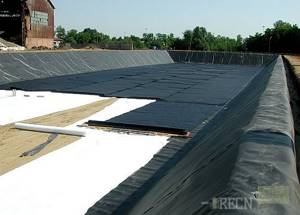
Installation of butyl rubber pond film
Laying this canvas is carried out using 2 methods:
- Using special tape for waterproofing with butyl rubber.
- Using an adhesive solution to seal the seams.
Important! Each of the options is available for installing pond waterproofing yourself and does not require specific equipment or professional skills.
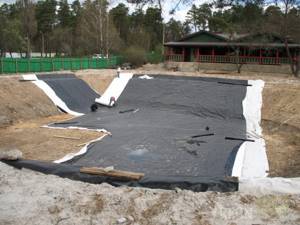
Types and characteristics of film for artificial ponds
The modern landscape design market offers us the following waterproofing options: polyethylene film, PVC material (polyvinyl chloride) and butyl rubber pond film.
PVC film
Polyethylene film is the most inexpensive material of this kind, but at the same time the most fragile (the warranty is only 2-3 years).
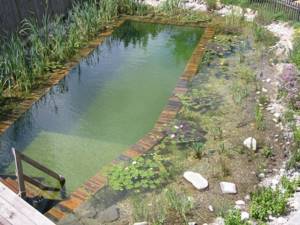
PVC film is a very durable material that has high elasticity and waterproofing
Technical characteristics of PVC film:
- Weight of one m2 from 0.5 kg to 1 kg;
- Thickness 0.5-1.2mm;
- Elasticity index 200%;
- To break the integrity of the polyvinyl chloride film coating, mechanical action from sharp glass or metal is required.
Butyl rubber film
Butyl rubber film is a durable and reliable material that will serve you for a long time (up to 50 years). A favorite material for builders because it is easy to work with. Also, such material is not subject to destruction from sunlight (cracks do not form) and temperatures (this is very convenient, because you do not need to drain water from the pond for the winter). Safe for the aquatic environment (compatible with fauna and flora). Another advantage is that this film is black, and this helps create the appearance of a deep bottom in the finished version of the pond.
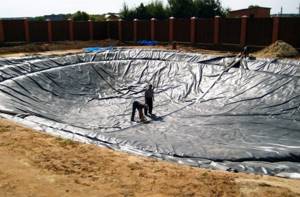
Butyl rubber film
Technical characteristics of rubber film:
- The weight of one m2 is approximately 1.5 kg;
- Thickness 1.02mm;
- Elasticity index 300%;
- To break the integrity of the butyl rubber film coating, mechanical action from wood or metal is required.
If, nevertheless, you were able to cut or somehow damage the film, then using rubber mastic you can repair any hole (such as a repair kit).
Rolls of rubber film are produced in fairly large widths (3-15 meters), which allows for a complete, seamless coating of small ponds.
Flexible butyl rubber material will follow any shape and outline of the pond. And the folds will disappear behind water, stones and plants. Experts advise using a geosubstrate to protect the rubber film from the effects of rhizomes.
Tips for choosing film
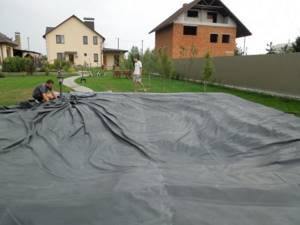
You can't do it without helpers!
It can be seen that there are now plenty of materials for covering swimming pools and artificial reservoirs
Therefore, it is very important to make the right choice. We hope these criteria will help you:
- Size and depth of the pond. If the depth of the reservoir is less than a meter, then a plastic film 0.5 mm thick will be sufficient; if the depth is up to 2 meters, then you need PVC film 1mm thick; if your pond is more than two meters deep and wide enough, then use butyl rubber film to cover it;
- Your choice should also be dictated by what you plan to place in the pond (additional objects - water cascades, a waterfall, a fountain, fish, or if you plan to swim in the pond).
Characteristics of features. Points for and against"
Polyethylene film
- The main advantage is low cost , the ability to replace the coating if damage is caused to its integrity. Resistance to decay, bioinertness. Light weight. Ability to join by welding.
- The main disadvantage is fragility ; influence on water turbidity and blooming.
PVC film
- The main advantage is environmental friendliness and high resistance to bioaggression . It has high tensile strength, elasticity and friction coefficient, which facilitates the installation of the bottom in tension and the design of coastal slopes. A two-layer membrane and a higher density than water provide 100% tightness. Frost-resistant, not afraid of root growth, and has high chemical resistance.
- The main disadvantage is the high level of moisture in adjacent soils , as well as relative fragility (10 years).
Butyl rubber film EPDM
The main advantage is a new generation material with a number of unique physical and technical properties :
- increased tensile and puncture strength;
- technological accessibility of installation;
- exceptional resistance to extreme weather conditions;
- subject to fragmentary repairs;
- environmentally friendly for living organisms;
- universal in finishing any surface (soil, stone, wood, concrete);
- provides maximum membrane width (up to 60 m);
- allows you to give the pond any shape or change it if desired;
- the range of components allows you to seal pump inlets, problem areas, and corners of the reservoir;
- exceptional durability (up to 50 years) allows us to talk about cost-effectiveness, even at prices higher than for PVC.
The deficiencies have not been identified at this time.
Decorative film with gravel
- The main advantage is the decorative effect , which allows you to create the illusion of a bottom covered with sand and stones, design the entrance to a reservoir, imitate a dry riverbed, and make the banks more natural. The film is produced with a coating of fine gravel and coarse gravel (like pebbles).
- The disadvantages are the same as those of PVC film, since it is the basis of a decorative fabric.
Selection rules
When choosing a film for arranging a pond, you need to take into account not only the decorative features of the material
It is equally important to correctly calculate the waterproofing consumption and take into account some of its operational features
When calculating material consumption, it is necessary to include some reserve. In general, the following formulas should be used:
- film length = pond length + 2 depths + allowances of 30-50 cm on each side;
- film width = reservoir width + 2 depths + allowances of 30-50 cm on each side.
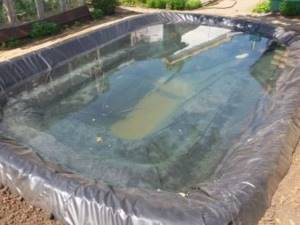
As for performance characteristics, the most important criterion influencing the selection of film thickness is the conditions in which the reservoir will be used. Here the following factors must be taken into account:
- the more uneven and bumpy the bottom is, the thicker the film base should be;
- when the depth of an artificial reservoir is less than 1 m, a film 0.5 mm thick will be sufficient;
- for reservoirs with a depth of 1-2 m, it is better to take the material in a layer of 1 mm;
- for artificial reservoirs with a depth of more than 2 meters, preference should be given to butyl rubber film.
The choice of base material can also be influenced by the complexity of the shape of the garden pond, the presence of elevation changes, and the presence of waterfalls and fountains. In addition, you need to think in advance whether the pond will be used for breeding live fish or swimming.
Application of the algorithm when creating a decorative pond
The pond design includes the shape as well as individual options. It should be tied to some place in the garden, chosen from the position of illumination, distance from large trees, the absence of any kind of slope exceeding five degrees, as well as protection from continuous wind.
We recommend following the link, you will learn everything about country gazebos. In this article you will find a lot of ideas for designing a rutaria. You may also be interested in how to make a large table for your garden.
- The area of the future pond must be cleared of turf and stones, and then leveled.
- Using a cord, you need to lay out the outline of the reservoir that will be built.
- Preparing the pit, extracting the soil in steps, initially a contour is laid approximately 40 cm deep, along which the hole should be deepened up to 70 cm, accordingly, a new contour is formed. The next excavation should reach 1.2 meters or even more.
- The bottom needs to be compacted, and all the stones that come across should be driven into the ground, then backfilled with wet sand.
- This pit must be covered with geotextiles, extending the edge of the canvas approximately 50 centimeters beyond the original contour, while carefully spreading it over the entire bottom.
- To obtain a clear edge of the pool, it is necessary to place a rubber hose along the future edge.
- Waterproofing must be prepared according to the existing size of the pond, while gluing the sheets in those situations where this is necessary.
- The film should be spread on top of the geofabric, straightening out the existing folds and bringing the edges beyond the boundaries of the pond.
- In order to fix the film on the bottom in the corners, it is necessary to place large stones on substrates made of geotextiles, which will also play a decorative role.
- The pond should be filled with water using a hose, the stream should be directed into the middle, after which the film should be spread again both at the bottom and on the shore.
- The edges of the film on the shore should be secured with metal or wood pins.
- Now you need to decorate the bank, compacting it with coconut mats or laying turf on the ground.
- You can plant plants on the banks of the pond, as well as in it itself.
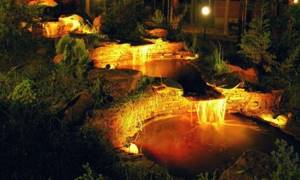
Illuminated pond
You can illuminate the pond using LED lamps, which can be ground-based, underwater, or floating; in addition, lamps are available for sale that operate from solar energy collected during the day.
Return to content
DIY natural pond without film
Without film, alternative options for sealing a reservoir are possible:
- Bentonite mats are one of the types of building materials based on granulated clay located between two layers of synthetic fabric. Upon contact with liquid, the clay layer turns into a gel-like substance. Bentonite strands secure the joint elements. It doesn’t take much time for installation work. Such material can withstand several dehydration revolutions.
- Polyurea spray technology. The material hardens within a few minutes; when used, it can cope with heavy loads. Waterproofing work is carried out by a qualified specialist.
- Spraying liquid rubber is one of the most expensive and modern options. The service life of such material is unlimited. The fabric stretches 450 percent. An environmentally friendly product, resistant to corrosive changes and temperature changes. During installation, you must be able to use modern equipment, as well as have technological knowledge.
- Plastic containers with a volume of up to 50 cubic meters are an expensive material and difficult to install. However, it is not possible for a specialist to install such a pond on the site. The service life is unlimited and does not provide for individual care.
Pond made of plastic mold
For summer residents there are no restrictions in arranging the site. To turn ideas into reality, there are various sealed materials with exceptional technical parameters. All that remains is to choose the most suitable option and decorate the area with a pond.
Features of decorative film with gravel
You can aesthetically decorate a pond with a film coating with gravel. The pebbles are pre-glued onto the plastic using waterproof glue. This film follows the curves of the coastline, which looks natural and beautiful.

Interesting solution PHOTO: landcompany.ru
The weight of the product is impressive, up to 8 kg per m². The size of the stones is 7-10 mm.
Pros:
- aesthetic and naturalistic appearance of the reservoir;
- the possibility of creating a natural coastline;
- strength.
Minuses:
- heavy weight;
- high price;
- service life will not exceed 10 years.
Purpose of film for a garden pond
The main purpose of a film for a pond is waterproofing. It holds water in the pit, preventing it from penetrating into the ground. This is a kind of membrane partition that holds liquid within the required boundaries.
You can use other options for constructing an artificial reservoir, for example, a concrete base. But such work will be more labor-intensive. In addition, you need to think about how to clean it in advance. That is why many owners choose to use the optimal technology - constructing a pond with a film bottom.
Before choosing a film as insulation for a reservoir, you need to determine what the benefits of its use are. And it is as follows:
- rotting of the material is excluded;
- the film can be used on any soil and on different bases;
- at any time, with minimal effort, you can reorganize the reservoir;
- it is possible to choose a different coating pattern that will increase the attractiveness of the artificial pond on the site.
And most importantly, all work on laying the film can be done with your own hands. This does not require any special skills
The main thing is to choose the right coating according to the technical characteristics.
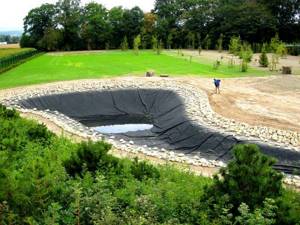
Photo: sotka.guru Using film you can create any outline of a pond, including the most complex
Butyl rubber film for ponds and what to eat it with
One of the most modern methods of pool waterproofing is laying butyl rubber. What is he? In fact, this is the same PVC film, only rubberized. Thanks to this, it has many advantages, the main ones being the following:
- increased elasticity due to the presence of rubber molecules, and the material is natural, high-quality, and can withstand stretching 3 times greater than its original form;
- easily tolerates any temperature, from -45 degrees to +90, does not deform;
- increased insulation, double taping of seams, which allows maximum water retention; no need to replenish the reservoir for several years (without taking into account evaporation);
- absolute environmental safety for fish and other inhabitants of your pond, the material does not have easily separated molecules, is non-toxic, and not harmful to humans.
No special preparation is required to install butyl rubber. Therefore, despite its relative high cost, it is obtained at the price of ordinary film, if you subtract the price of spandex, sand and other components that are necessary for laying ordinary PVC material. Rubber film for ponds is sold in almost every hardware store in a large assortment; you can choose the required roll size, which is a big advantage.
Best PVC Films for Ponds
Such products are most often chosen if you want to save money, since they are an inexpensive option. Unlike analog materials from our TOP, its service life is about 15 years. The main material for the manufacture of the membrane is polyvinyl chloride. Here are two of our top picks in this category, chosen for their versatility and ease of use.
AlfaFol Oase
AlfaFol Oase polyvinyl chloride film is relevant for creating a pond or pool of both small and large sizes, thanks to a maximum roll width of 10 m and a length of 20 m, although smaller parameters can be selected if necessary. It is easy to install and, if necessary, can be glued together without any problems with special glue.
The manufacturer offers material of various thicknesses - 0.5, 0.8 and 1 mm, depending on the size and depth of the reservoir. It is made from pure PVC, without the addition of cadmium and other similar components, which increases the service life of the product.

Advantages
- Good resistance to UV radiation;
- Does not deteriorate from exposure to rainwater;
- Available in two colors – olive and black;
- Does not decompose;
- Frost-resistant - can withstand temperatures down to -40 degrees;
- Does not harm plants in the pond.
Flaws
Not detected.
Ergis PVC 1.0 mm
...Users prefer to buy this PVC pond film largely due to its service life of approximately 40 years, which does not decrease when using such waterproofing even in harsh conditions... Expert opinion
First of all, this film is intended for large reservoirs up to 4 m deep; in such operating conditions, its thickness of 1 mm is considered optimal. It adequately withstands exposure to sunlight and low temperatures, is easy to care for, as it can be cleaned with household chemicals, and is quite elastic. Thanks to the latter, it is possible to install the product in a pit of almost any shape, even a non-standard one. The risk of damage to the canvas is practically eliminated here due to the high strength and density, but if this does happen, it will not be difficult to repair it yourself using a special PVC glue.
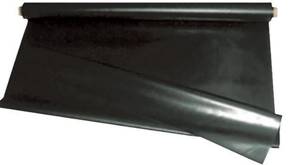
Advantages
- Environmentally friendly and safe;
- Immune to microorganisms;
- Reliable connection of seams;
- Can be used in winter;
- Long-term preservation of aesthetic appearance.
Flaws
At first there is a slight smell.
How to choose a pond film
When it comes to a tiny pond without fish and special vegetation, you can purchase a cheap polyethylene covering. Such material, with modest parameters of the reservoir, can fully cope with the load.
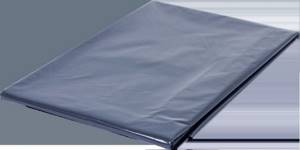
Polyethylene for ponds is sold in black or brown PHOTO: leroymerlin.ru
If the tank is deeper, then you can consider purchasing a PVC covering. Elasticity and other qualities provide decent waterproofing; living inhabitants can be safely released into such a reservoir.
The color of the film can be black, olive, blue, turquoise, gray. Designers recommend choosing black or olive color - these shades will make the pond in the garden natural, allowing the sky to be reflected in the water.
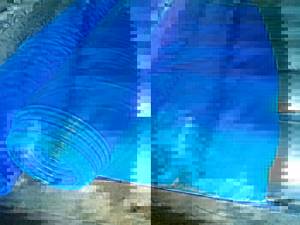
Bright colors will not look natural PHOTO: minsk.deal.by
Butyl rubber is placed in deep and large reservoirs. Elasticity and strength are extremely important here, because the water pressure will be serious.
Synthetic rubber meets all requirements for quality and appearance.
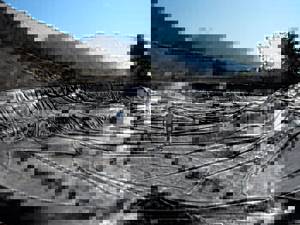
Butyl rubber waterproofing coating has very wide possibilities PHOTO: sadrium.ru
Streams can be formed with any commercially available materials.
If aesthetics come first, then you can immediately choose a film with a gravel coating.
Related article:
Pond at the dacha for fish breeding. Step-by-step instructions for constructing a pond for keeping fish with photo examples are in a separate publication on our portal.
How to build a decorative pond from film with your own hands
Anyone can build a pond with their own hands; there is nothing complicated about it. The main thing is to correctly calculate the parameters of the film and carefully carry out all stages of the work. If you plan to build a large pond, you will need to connect two or more parts of the covering. You can do this in one of the following ways:
- double-sided adhesive tape;
- assembly adhesive composition based on neoprene;
- adhesive composition for PVC intended for reservoirs;
- glue-sealant for PVC film;
- with a regular iron or film welding machine.
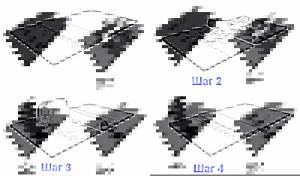
Photo: vse-postroim-sami.ru Film coating gluing technology
Tools and materials
To build a pond you need to prepare:
- film, dimensions can be calculated using the formula;
- sand;
- gravel;
- wood cuts for decoration;
- plants in pots;
- shovel and chainsaw.
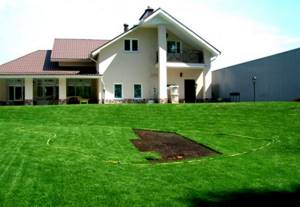
Photo: 7dach.ru Marking can be done with a regular hose
Step-by-step instructions for making a pond with your own hands
Let us consider all the stages of construction and decorative design of the banks of a small pond in more detail.
| Illustration | Description of action |
| Dig a two-level pond. The contour can be pre-marked with a watering hose. You need to start work from the top line. The bottom is formed last. Compact the banks with a shovel, and add a cushion of sand 5-10 cm thick to the bottom. Lay 2 layers of film. To avoid tearing it, it is better to take off your shoes. The covering should lie freely, without tension. When filled with water, it will take the desired shape. |
| Press the film against the banks with stones. Fill the pond with water and leave it for a day to check the tightness. |
| To create higher banks, add sand to a small bank. |
| Compact the sand with your hands and cover the shaft with film. Trim off excess edges of the film. |
| Dig a small groove near the banks, tuck the film into it and cover it with earth. Saw the tree into small sections up to 10 cm thick. |
| Decorate the coastline with saw cuts. Rinse the gravel and pour it onto the bottom of the reservoir. |
| Decorate the banks with plants. The pond is ready. |
To create such a decorative pond, only 250 rubles and 2 days of work were spent. Additionally, it was possible to lay a layer of geotextile between the sand and the film to prevent vegetation from tearing the coating. Accordingly, the cost of work will increase slightly.
You can watch all the steps in more detail in the video:
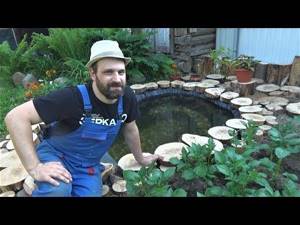
Watch this video on YouTube
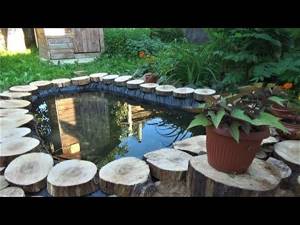
Watch this video on YouTube
How to care for a pond made of film?
The maintenance of an artificial structure falls entirely on its owner and depends on the time of year. If proper care is not taken, the film for reservoirs and ponds will crack and become dirty. The following requirements must be met:
- In the warm season, they maintain the water level and clear it of fallen dirt and leaves.
- As the plants grow, they are pruned and thinned.
- Before the onset of cold weather, all flora and fauna are taken out and placed in an aquarium in a warm room until spring.
- If it is not possible to drain the water, then ice compensators are used. They prevent the film from tearing during freezing. Empty containers and plastic bottles are well suited for these purposes.
